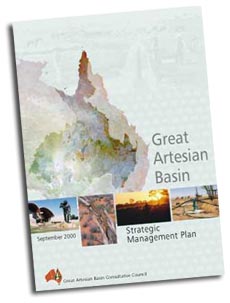 The Great Artesian Basin has provided water for inland areas of Australia since 1878. Basin water is extracted through bores and is the only source of water for mining, tourism and grazing in the states of Queensland, New South Wales and South Australia states, as well as the Northern Territory. The underground water returns $3.5 billion a year from farming, mining and tourism, says the Great Artesian Basin Coordinating Committee.
The Great Artesian Basin has provided water for inland areas of Australia since 1878. Basin water is extracted through bores and is the only source of water for mining, tourism and grazing in the states of Queensland, New South Wales and South Australia states, as well as the Northern Territory. The underground water returns $3.5 billion a year from farming, mining and tourism, says the Great Artesian Basin Coordinating Committee.
Recently the Australian Science Media Centre hosted a Background Briefing session which is available online. Web users can read and hear three experts discuss the issues. John Hillier's presentation is available here. There has been an enormous decrease in the pressure flow from 1800-2000 - without the addition of new needs for the planned coal extraction at Wandoan. The sleepy farming community is presently under the microscope for coal mining and a section of the Melbourne to Darwin inland rail. Planning is underway to construct the rail line from Wandoan to the port at Gladstone.
Lynn Brake's presentation is available here and shows us that the water is 2 million years old.
A 15-year Great Artesian Basin Sustainability project started in 1990 aims to protect the water supply and the hydraulic pressure necessary to access it. Today, there are still some 3,000 bores which pour water into 21,130 miles of open bore drains, with 90 per cent of the water evaporating in the outback heat. But more than 1,052 bores have now been controlled and tens of thousands of miles of open drains removed and pipelines laid, saving 272 gigalitres of water a year. Andy Love, from Flinders University in Adelaide said that an expansion in exploration and mining activities in the area will place increased demands on securing groundwater allocations for economic development. Clearly a balance between development and environmental protection needs to be achieved.
However, this is not possible without increased knowledge about the amount of groundwater that can be safely extracted.
Even in the early 1900s, it was realised that extraction and use of waters from the Basin was unsustainable. This realisation led to the first Interstate Conference on Artesian Water which was held in 1912. There have been some collaborative successes. Since the basin occupies 70% of Queensland what happens here will be very significant. However it is of concern that the GAB committee feel that uncertainty of rights and responsibilities is a threat to value of the basin and its management. The documents can be downloaded from here.
Currently available for community comment is the Logan Basin draft Resource Operations Plan. It includes water in a watercourse, lake, wetland, subartesian aquifer or spring in the Southern Moreton Bay Islands area. There is a moratorium for the subartesian area of North Stradbroke Island. All available information and documents re Logan are available here.

 The Great Artesian Basin has provided water for inland areas of Australia since 1878. Basin water is extracted through bores and is the only source of water for mining, tourism and grazing in the states of Queensland, New South Wales and South Australia states, as well as the Northern Territory. The underground water returns $3.5 billion a year from farming, mining and tourism, says the Great Artesian Basin Coordinating Committee.
The Great Artesian Basin has provided water for inland areas of Australia since 1878. Basin water is extracted through bores and is the only source of water for mining, tourism and grazing in the states of Queensland, New South Wales and South Australia states, as well as the Northern Territory. The underground water returns $3.5 billion a year from farming, mining and tourism, says the Great Artesian Basin Coordinating Committee.